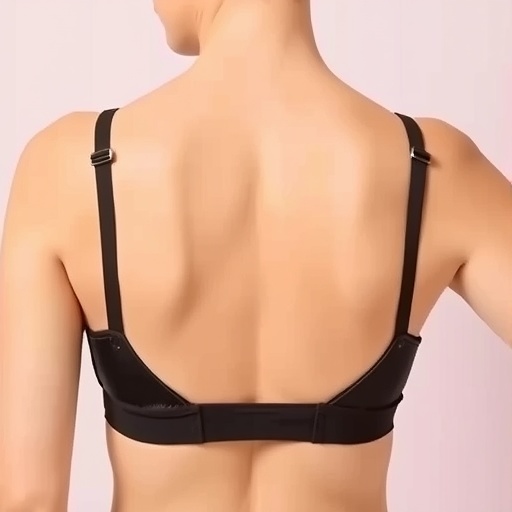A groundbreaking study from the University of Portsmouth exposes a hidden dilemma in the design of high-support sports bras—early evidence suggests that while these bras excel at minimizing breast bounce during vigorous exercise, they may inadvertently impose increased mechanical load on the spine, potentially elevating the risk of back dysfunction and chronic musculoskeletal pain. This revelation challenges the longstanding industry emphasis on maximizing bounce reduction as the primary criterion of sports bra performance and ushers in a new paradigm that demands a nuanced balance between breast support and spinal health.
Sports bras have long been hailed as essential apparel for physically active women, with their ability to limit breast motion lauded as critical not only for comfort but also for reducing exercise-induced breast pain. Traditionally, the development of these garments has centered on minimizing the vertical and lateral displacement of breast tissue during high-impact activities such as running. However, the University of Portsmouth research team employed sophisticated biomechanical modeling to probe deeper into the consequences of excessive breast stabilization, uncovering biomechanical trade-offs previously overlooked.
At the heart of this research is a pioneering female-specific musculoskeletal model that integrates detailed anatomic and dynamic data to simulate torso kinematics and spinal loading under varying degrees of breast support during running. Utilizing cutting-edge motion capture technology, ground reaction force plates, and 3D surface scanning, the team recreated the complex interaction between breast motion and spine dynamics in unprecedented detail. These simulations revealed that bras engineered to eliminate breast bounce entirely impose augmented rotational forces and moments on the thoracolumbar spine, which may exacerbate spinal muscle fatigue and contribute to an increased risk of lumbar back pain.
In a rigorous exploration titled "Modelling Female Breast Motion During Running: Implications of Breast Support on the Spine," soon to be published in the European Journal of Sport Science, lead researcher Dr. Chris Mills underscores the essential conundrum facing sports bra innovation: achieving an optimal equilibrium between breast comfort and holistic musculoskeletal well-being. The data demonstrated that when breast motion is overly restricted, compensatory postural and muscular adjustments may elevate spinal loading beyond physiological norms, potentially triggering cumulative microtrauma.
These findings disrupt the conventional assumption that maximal breast immobilization equates to maximal benefit. In fact, the study indicates that an ideal sports bra design might entail a degree of controlled breast displacement that suffices to diminish pain and tissue strain but avoids overburdening spinal structures. The implications span beyond product design, prompting a reevaluation of wearable biomechanics and female musculoskeletal health during exercise, a domain historically underrepresented in biomechanical research.
Building upon two decades of research by the University of Portsmouth’s Research Group in Breast Health, this study adds a pivotal dimension to the understanding of how breast movement interfaces with spinal mechanics. Earlier investigations predominantly quantified breast displacement and breast-related discomfort or pathology, but this integrative approach highlights the spine as a downstream biomechanical consequence of breast support. Professor Wakefield-Scurr, known colloquially as the ‘Bra Professor,’ emphasizes the urgency of this research, advocating for collaboration between biomechanists, materials scientists, and garment engineers to innovate bras that do not compromise spinal integrity.
The methodological novelty of employing subject-specific musculoskeletal models allowed the researchers to dissect the individual muscular contributions and spinal moments arising under different simulated bra support conditions. Such precision modeling paves the way for personalized interventions, from recommending tailored rehabilitation programs following breast surgeries to designing bras customized to an individual’s unique biomechanical profile. This could herald a transformative shift in sportswear technology towards bespoke ergonomic solutions that prioritize comprehensive musculoskeletal health.
Importantly, the simulations indicated that bras eliminating breast bounce increased spinal rotational moments significantly, hinting at potential risk factors for lumbar musculoskeletal disorders. This challenges designers to reconsider parameters traditionally held sacrosanct, such as maximum compression and immobilization, and instead adopt design philosophies that distribute mechanical loads more balancedly. Future iterations may feature adaptive support zones or dynamic fabric technologies responsive to motion, further optimizing the interaction between the breast and spine during physical exertion.
Dr. Mills articulates a vision where understanding the interplay between breast motion and spinal loading informs not only garment design but also clinical practice. “Understanding individual muscular contributions will facilitate the development of pre-surgical rehabilitation programs and bras that synergize with the female body’s complex biomechanics,” he remarks. This perspective champions a multidisciplinary approach combining biomechanics, clinical insight, and material innovation to enhance women’s health outcomes.
The study’s timing is notable, coinciding with the Research Group in Breast Health’s bra testing unit celebrating its 10th anniversary—an era marked by more than a million breast bounce measurements across 8,000 women. This vast dataset underpins ongoing refinements in sports bra performance metrics and underscores the importance of evolving from simple displacement reduction towards holistic biomechanical health. It also signals the growth of female-centric biomechanical research, an area ripe for further exploration given the anatomical and physiological distinctions impacting women’s exercise physiology.
In summary, this pioneering investigation unveils a vital, previously underappreciated biomechanical trade-off: the pursuit of absolute breast immobilization in sports bras may paradoxically compromise spinal health by increasing internal spinal loads during high-impact activities like running. The research invites a radical rethink of bra design principles, advocating for a science-driven balance that preserves comfort and breast support while safeguarding the spine. As sports bras continue to evolve, embracing these insights could catalyze a new generation of garments that are not only performance-enhancing but also integral to long-term musculoskeletal wellness.
Subject of Research: People
Article Title: Modelling Female Breast Motion During Running: Implications of Breast Support on the Spine
News Publication Date: 3-Apr-2025
Web References:
- European Journal of Sport Science: https://onlinelibrary.wiley.com/doi/10.1002/ejsc.12290
- University of Portsmouth Research Group in Breast Health: https://www.port.ac.uk/research/research-groups-and-centres/research-group-in-breast-health
References:
Mills, C., et al. (2025). Modelling Female Breast Motion During Running: Implications of Breast Support on the Spine. European Journal of Sport Science. DOI: 10.1002/ejsc.12290
Keywords: Spinal injuries, breast motion, sports bras, musculoskeletal modeling, biomechanical load, lumbar biomechanical strain, female musculoskeletal health, exercise physiology




